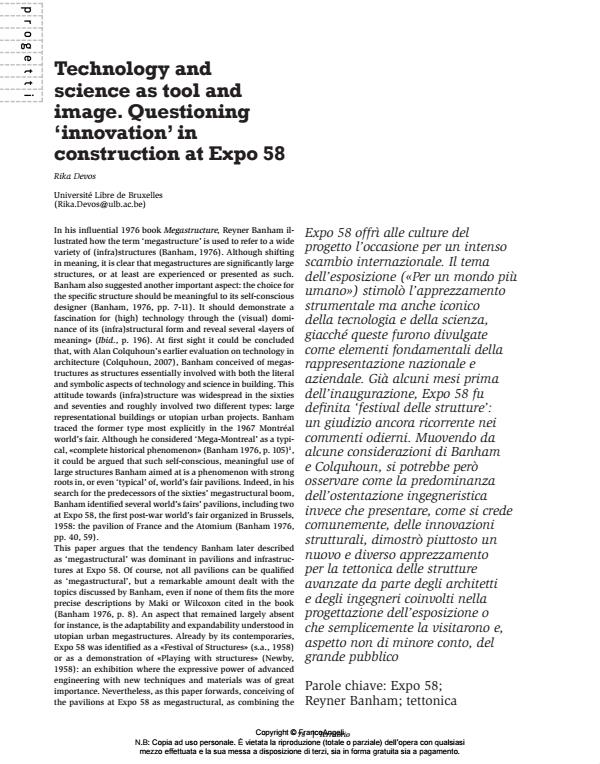Technology and science as tool and image. Questioning ‘innovation’ in construction at Expo 58
Titolo Rivista TERRITORIO
Autori/Curatori Rica Devos
Anno di pubblicazione 2014 Fascicolo 2013/67 Lingua Inglese
Numero pagine 7 P. 78-84 Dimensione file 1754 KB
DOI 10.3280/TR2013-067013
Il DOI è il codice a barre della proprietà intellettuale: per saperne di più
clicca qui
Qui sotto puoi vedere in anteprima la prima pagina di questo articolo.
Se questo articolo ti interessa, lo puoi acquistare (e scaricare in formato pdf) seguendo le facili indicazioni per acquistare il download credit. Acquista Download Credits per scaricare questo Articolo in formato PDF

FrancoAngeli è membro della Publishers International Linking Association, Inc (PILA)associazione indipendente e non profit per facilitare (attraverso i servizi tecnologici implementati da CrossRef.org) l’accesso degli studiosi ai contenuti digitali nelle pubblicazioni professionali e scientifiche
Expo 58 offered an opportunity to the culture of design for intense international dialogue. The subject of the exposition (‘for a more humane world’) stimulated not only instrumental, but also iconic appreciation of technology and science, to the extent that these were advertised as fundamental elements of national and corporate representation. Expo 58 had already been defined a few months before the inauguration as ‘a festival of structures’: an opinion that still recurs in comments today. However, starting from some considerations made by Banham and Colquhoun, one may observe that the predominance of engineering ostentation instead of just presenting, as is commonly believed, structural innovations, demonstrated a new and different appreciation for the tectonics of advanced structures by the architects and engineers involved in the design of the exposition or simply by those who visited it and, no less important, by the public at large.
Keywords:Expo 58; Reyner Banham; tectonics
- Addis W., 1997, «Design Revolutions in the History of Tension Structures», Structural Engineering Review, n. 6, pp. 1-10.
- Banham R., 1976, Megastructure. Urban Futures of the Recent Past, Thames & Hudson, London.
- Colquhoun A., 2007, «Symbolic and Literal Aspects of Technology», in Braham W.W., Hale J.A. (eds.), Rethinking Technology. A Reader in Architectural Theory, Routledge, New York, pp. 266-269.
- Devos R., 2008a, Modern at Expo 58. Discussions on Post-war Architectural Representations, Ph.D. thesis, Faculteit Ingenieurswetenschappen, Ghent.
- Devos R., 2008b, The Brussels Atomium and the Popular Appeal of ‘Humanized’ Nuclear Science, Proceedings of Docomomo. Import/Export «Postwar Modernism in an Expanding World, 1945-1975», Docomomo, New York, pp. 421-428.
- Devos R., 2009, «A Cold War Sketch. The Visual Antagonism of the Usa vs the Ussr at Expo 58», Revue belge de Philologie et d’Histoire, n. 87, pp. 723-742.
- Elno K.N., 1965, »Expo-stijl», De Vorm der dingen, Hasselt, Heidelandt, Vlaamse pockets n. 156, p. 113.
- Espion B., Devos R., Provost M., 2006, «Entre ingénierie et architecture. Innovations structurales», in De Kooning M., Devos R. (dir.), L’architecture de l’Expo 58. ‘Pour un monde plus humain, Dexia/Mercatorfonds, Brussels, pp. 100-127.
- Everaerts de Velp C., 1955, The Theme of ‘Brussels 1958’, Commissariat General of the Government, Brussels, p. 8.
- Frampton K., 1995, Studies in Tectonic Culture. Poetics in Construction in Nineteenth and Twentieth Century Architecture, Mit, Cambridge/London.
- Giedion S., 1941, Space, Time and Architecture. The Growth of a new Tradition, Harvard U.P., Cambridge, MA.
- Greenhalgh P., 1988, «Origins and Conceptual Development», in Id., Ephemeral Vistas. The Expositions Universelles, Great Exhibitions and World’s Fairs, 1851-1939, Manchester U.P., Manchester, pp. 3-26.
- Kint J., 2001, Expo 58 als belichaming van het humanistisch modernisme, 010, Rotterdam.
- Lambilliotte M., 1958, «Sens et esprit de l’exposition de Bruxelles 1958», Eventail. Album 1958, n. 23, p. 11.
- Matthews S., 2007, «Cedric Price as Anti-architect», in Anstey T., Grillner
- K., Hughes R. (eds.), Architecture and Authorship, Black Dog, London, pp. 142-147.
- Newby F., 1958, «Playing with Structure. Some Impressions of the Brussels Exhibition», The Builder, n. 194, pp. 354-356.
- Otto F., 1958, «Formes, techniques et constructions humaines», L’Architecture d’Aujourd’hui, n. 78, p. 4.
- Picon A., 1997, ed., L’Art de l’Ingénieur, Editions du Centre Pompidou and Le Moniteur, Paris.
- Puente M., 2000, 100 Años Pabellones de Exposición. 100 Years Exhibition Pavilions, Gustavo Gili, Barcelona.
- Robichon F., 1983, «Vers une architecture d’exposition 1925-1970», in Aa.Vv., Le Livre des Expositions Universelles 1851-1989, Union Centrale des Arts Décoratifs, Paris, pp. 233-242.
- S.a., 1955, «Guide du commissaire général de section», Fund Expo 58, n. 4.11.00/A6, State Archives, Brussels.
- S.a., 1958, «Architecture at Brussels: Festival of Structure», Architectural Record, n. 123, pp. 163-170.
- Sarger R., 1958a, «Valeur plastique des structures à l’exposition de Bruxelles», L’Architecture d’Aujourd’hui, n. 78, p. 6.
- Sarger R., 1958b, «A propos de l’exposition international et universelle de Bruxelles», L’Architecture d’Aujourd’hui, n. 78, p. 4.
Rica Devos, Technology and science as tool and image. Questioning ‘innovation’ in construction at Expo 58 in "TERRITORIO" 67/2013, pp 78-84, DOI: 10.3280/TR2013-067013